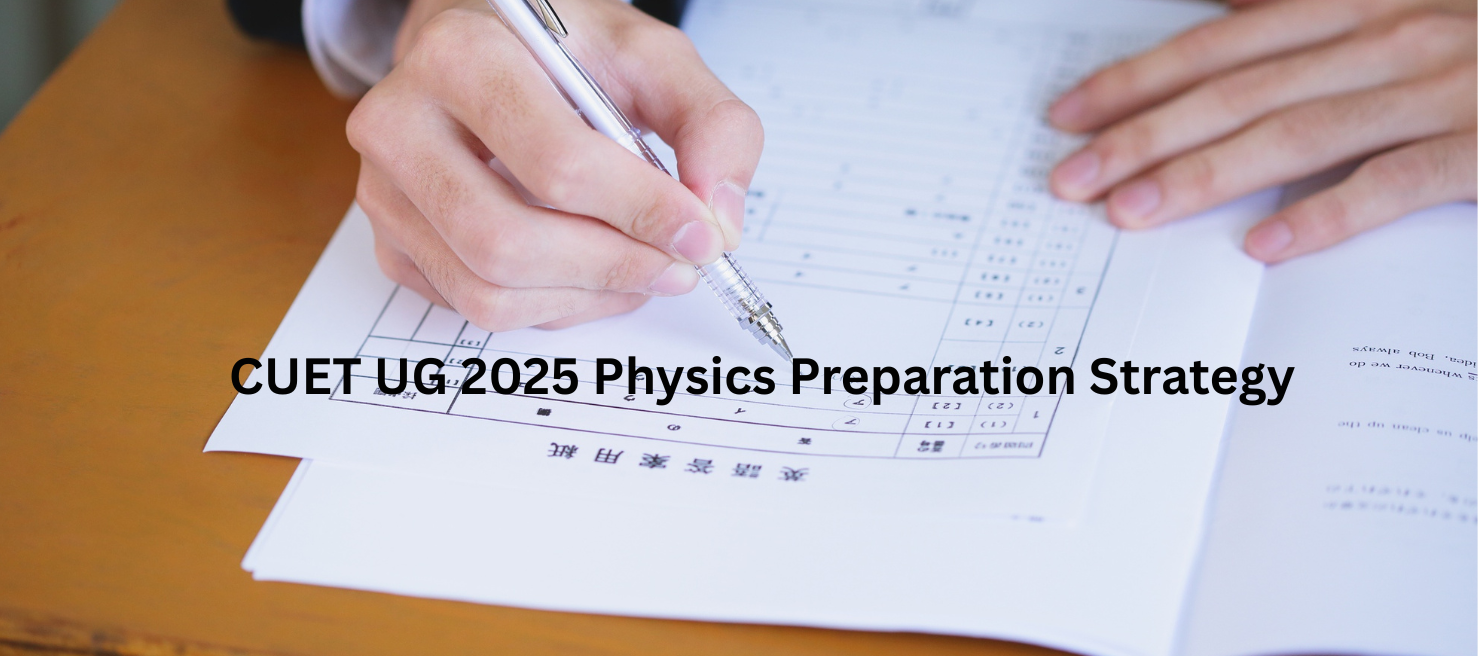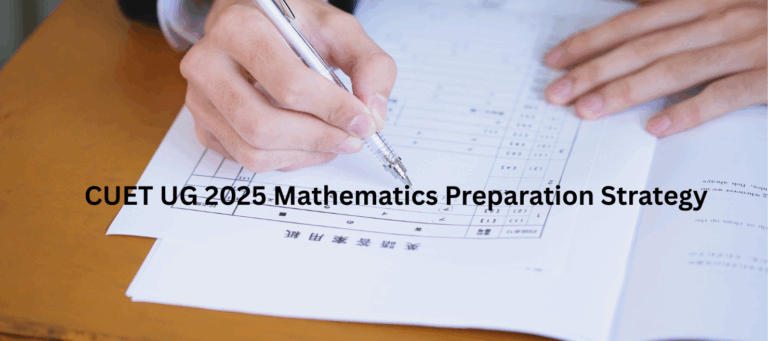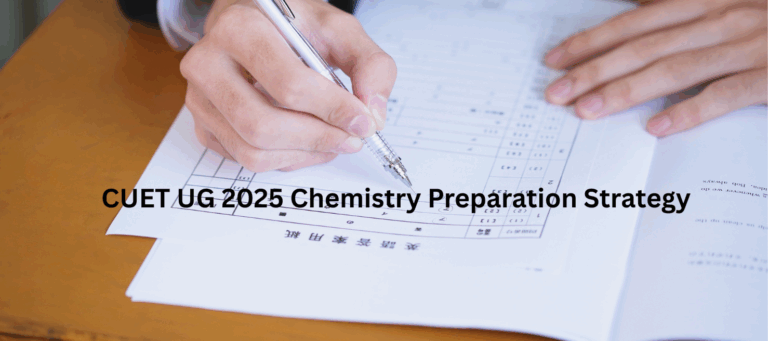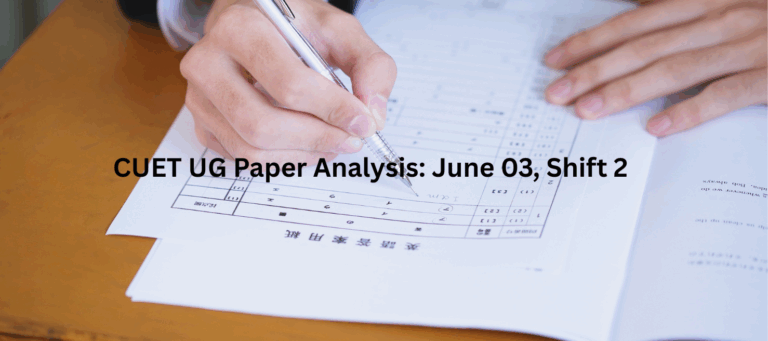
The CUET exam is a national-level entrance examination conducted by the National Testing Agency. Every year, over 10 lakh students appear for the exam, and those who qualify for the exam are eligible for admission into various private, state, and central universities. The CUET exam will be held from May 13th to June 3rd, 2025. Candidates appearing for the exam can check the detailed exam analysis for each shift on our official website, i.e., collegedost. in.
Candidates who aspire to appear for the CUET UG 2025 exam have to understand the CUET exam pattern, CUET syllabus, admission and counselling processes. Candidates have to devise a strict preparation strategy to succeed in the exam and secure admission in a prestigious university. Check our detailed guide below for a detailed exam analysis of the CUET Physics subject.
Also read: CUET Maths Preparation Strategy
CUET Exam Pattern 2025
Skills such as language, aptitude, and subject knowledge are tested in the CUET exam. Candidates who can excel in these areas are able to secure qualifying marks and are eligible for admission into various engineering colleges. Check the CUET exam pattern from the table below:
| Section | Duration of the Exam | No of Questions | Questions Type |
| Section IA- Language | 60 Minutes for Each Subject | 50 Questions | Reading Comprehension.GrammarVocabulary |
| Section II- Domain Specific | 50 Questions | Subject-specific questions. | |
| Section III- General Test | 50 Questions | General AwarenessAptitudeReasoning |
PYQS of CUET UG 2025 Physics Subject
Previous years’ questions are an indispensable source for your preparation. These questions help students understand the difficulty level of the questions and help them understand the amount of preparation they need to solve the questions effectively in the exam. Download the previous year’s questions from below:
| CUET UG Physics Previous Year’s Question Papers | ||
| Date/Year | Question Paper | Solution |
| 2022: CUET Physics | Download here | Download here |
| 2023: June 15 Shift 2 2023: June 20 Shift 3 2023: July 2 Shift 3 | Download here Download here Download here | Download here Download here Download here |
| 2024: CUET UG Physics | Download here | Download here |
CUET Syllabus 2025 for Physics Subject
Understanding the CUET UG exam syllabus for each subject helps you prepare effectively for the exam. This helps you understand where to focus more to obtain more marks, and most importantly, it helps you understand how to strategise your exam plan to complete the syllabus and effectively prepare for the exam.
CUET Physics Syllabus
Check the CUET syllabus for the Physics subject here:
| Unit | Syllabus |
| Unit 1: Electrostatics | Electric charges and their conservation, Coulomb’s law – force between two-point charges, forces between multiple charges, superposition principle and continuous charge distribution. Electric field, electric field due to a point charge, electric field lines, electric dipole, electric field due to a dipole, torque on a dipole in a uniform electric field. Electric flux, statement of Gauss’s theorem and its applications to find field due to infinitely long straight wire, uniformly charged infinite plane sheet and uniformly charged thin spherical shell (field inside and outside). Electric potential, potential difference, electric potential due to a point charge, a dipole and system of charges, equipotential surfaces, electrical potential energy of a system of two point charges and of electric dipoles in an electrostatic field. Conductors and insulators, free charges and bound charges inside a conductor, dielectrics and electric polarisation, capacitors and capacitance, combination of capacitors in series and in parallel, capacitance of a parallel plate capacitor with and without dielectric medium between the plates, energy stored in a capacitor. |
| Unit 2: Current Electricity | Electric current, flow of electric charges in a metallic conductor, drift velocity and mobility, and their relation with electric current, Ohm’s law, electrical resistance, V-I characteristics (linear and non-linear), electrical energy and power, electrical resistivity and conductivity, temperature dependence of resistance. Internal resistance of a cell, potential difference and emf of a cell, combination of cells in series and in parallel. Kirchhoff’s laws, Wheatstone bridge. |
| Unit 3: Magnetic Effects of Current and Magnetism | Concept of magnetic field, Oersted’s experiment, Biot-Savart law and its application to current carrying circular loop. Ampere’s law and its applications to infinitely long straight wire, straight solenoid. Force on a moving charge in uniform magnetic and electric fields. Force on a current-carrying conductor in a uniform magnetic field. Force between two parallel current carrying conductors – definition of ampere. Torque experienced by a current loop in a magnetic field, moving coil galvanometer – its current sensitivity and conversion to ammeter and voltmeter. Current loop as a magnetic dipole and its magnetic dipole moment. Magnetic field intensity due to a magnetic dipole (bar magnet) along its axis and perpendicular to its axis. Torque on a magnetic dipole (bar magnet) in a uniform magnetic field, bar magnet as an equivalent solenoid, magnetic field lines. Para-, dia- and ferro-magnetic substances, with examples. |
| Unit 4: Electromagnetic Induction and Alternating Currents | Electromagnetic induction, Faraday’s law, induced emf and current, Lenz’s law, eddy currents. Self and mutual inductance. Alternating currents, peak and rms value of alternating current/voltage, reactance and impedance, LC oscillations (qualitative treatment only), LCR series circuit, resonance, power in AC circuits, wattless current. AC generator and transformer. |
| Unit 5: Electromagnetic Waves | Need for displacement current. Electromagnetic waves and their characteristics (qualitative ideas only). Transverse nature of electromagnetic waves. Electromagnetic spectrum (radio waves, microwaves, infrared, visible, ultraviolet, x-rays, gamma rays) including elementary facts about their uses. |
| Unit 6: Optics | Reflection of light, spherical mirrors, mirror formula. Refraction of light, total internal reflection and its applications, optical fibres, refraction at spherical surfaces, lenses, thin lens formula, lens-maker’s formula. Magnification, power of a lens, combination of thin lenses in contact, combination of a lens and a mirror. Refraction and dispersion of light through a prism. Scattering of light – blue colour of the sky and reddish appearance of the sun at sunrise and sunset. Optical instruments: microscopes and astronomical telescopes (reflecting and refracting) and their magnifying powers. Wave optics: wavefront and Huygens’ principle, reflection and refraction of plane wave at a plane surface using wavefronts. Proof of laws of reflection and refraction using Huygens’ principle. Interference, Young’s double hole experiment and expression for fringe width, coherent sources and sustained interference of light. Diffraction due to a single slit. Polarisation, plane polarised light. |
| Unit 7: Dual Nature of Matter and Radiation | Photoelectric effect, Hertz and Lenard’s observations, Einstein’s photoelectric equation – particle nature of light. Matter waves – wave nature of particles, de Broglie relation. |
| Unit 8: Atoms and Nuclei | Alpha-particle scattering experiment, Rutherford’s model of atom, Bohr model, energy levels, hydrogen spectrum. Composition and size of nucleus, atomic masses, isotopes, isobars, isotones. Radioactivity – alpha, beta and gamma particles/rays and their properties. Mass-energy relation, mass defect, binding energy per nucleon and its variation with mass number, nuclear fission and fusion. |
| Unit 9: Electronic Devices | Energy bands in solids (qualitative ideas only), conductors, insulators and semiconductors, semiconductor diode – I-V characteristics in forward and reverse bias, diode as a rectifier. |
CUET UG 2025: Physics Important Topics
The Physics section in CUET 2025 carries a total of 250 marks, with candidates allotted 60 minutes to complete the exam. Below are some key topics to focus on for adequate preparation.
| Unit | Important Topics(No of Questions) |
| Electrostatistics | Electric Charge and Electric Field(7)Electrostatic Potential and Capacitance (3) |
| Current Electricity | Current Electricity(6) |
| Magnetic Effects of Current and Magnetism | Moving charges and Magnetism.(5)Magnetism and Matter.(5) |
| Electromagnetic Induction and Magnetic Currents | Electromagnetic Induction.(1)Alternating Currents.(4) |
| Optics | Ray optics and Wave optics(4) |
| Electromagnetic waves | Electromagnetic Waves(5) |
| Atoms and Nuclei | Atoms and Nuclei(2) |
| Dual nature of matter and Radiation | Dual nature of matter(2) |
| Communication systems | Communication Systems(1) |
| Electronic Devices | Electronic Devices(5) |
CUET UG 2025 Physics 60-day Preparation Plan
The physics subject requires a solid amount of preparation to be able to score high and secure decent marks in the exam. Students can refer to the 60-day preparation plan to comprehensively cover the syllabus and gain a strong command over the CUET UG physics subject:
| Week | Topics to Cover | Focus Areas & Tasks |
| Week 1 | Electrostatics – Part 1 | Charges, Coulomb’s Law, Electric Field, Field Lines, Dipole. Read NCERT, make notes, and solve basic concept questions. |
| Week 2 | Electrostatics – Part 2 & Current Electricity – Part 1 | Gauss’s Law, Potential, Capacitance; Drift Velocity, Ohm’s Law. Derivations + NCERT problems. |
| Week 3 | Current Electricity – Part 2 & Magnetic Effects – Part 1 | Kirchhoff’s Laws, Wheatstone Bridge; Biot-Savart Law, Ampere’s Law. Practice circuits and field calculations. |
| Week 4 | Magnetism – Part 2 & EMI – Part 1 | Bar magnet, Magnetic Dipole, Torque; Faraday’s Laws, Lenz’s Law. Work on conceptual MCQs and derivations. |
| Week 5 | EMI – Part 2, AC & EM Waves | LCR, Resonance, Power in AC; Displacement Current, EM Spectrum. Practice numericals and revise formulas. |
| Week 6 | Optics – Part 1 | Reflection, Refraction, Lenses, TIR, Mirror/Lens Formula. Use diagrams and solve ray-tracing problems. |
| Week 7 | Optics – Part 2 & Dual Nature | Wave Optics, Interference, Diffraction; Photoelectric Effect, de Broglie Waves. Focus on derivations and numerals. |
| Week 8 | Atoms, Nuclei & Electronic Devices | Bohr Model, Radioactivity, Mass-Energy; Semiconductors, Diode I-V Characteristics. Practice short answer questions and MCQs. |
| Week 9 | Full Revision – All Units | Revise Week 1–4 topics. Create a formula sheet, solve quizzes, and highlight weak areas. |
| Week 10 | Full Revision – All Units + Mock Tests | Revise Week 5–8 topics. Attempt two full-length mock tests, analyse mistakes, and revise weak areas. |
Best Resources for CUET UG 2025: Physics
The physics subject requires a blend of conceptual and practical understanding to solve the numerical problems effectively. The right sources for your preparation help you effectively solve the numerical and theoretical questions. You can refer to the following sources for gaining a strong foundation in the CUET exam physics subject.
| Book Title | Author / Publisher | Purpose |
| NCERT Class 12 Textbook for Physics | NCERT | Core theory and concept foundation |
| NCERT Exemplar for Physics | NCERT | Advanced problems from the NCERT framework |
| Oswal’s Topper Handbook of Physics | Oswal Publishers | Quick revision, key formulas & chapter notes |
| Objective Physics | D.C. Pandey | Practice MCQs, concept-based questions |
| Concepts of Physics (Vol I & II) | H.C. Verma | Concept clarity and problem-solving |
| Fundamental Physics | Pradeep Publications | In-depth explanation and a wide variety of questions |
| Problems in General Physics | I.E. Irodov | Challenging numerical problems (for extra prep) |
CUET UG 2025 Physics Preparation Tips
Candidates frequently waste a lot of time studying for the NTA CUET UG 2025 because they are not given the right guidance. Appropriate instruction is necessary to save time and present for the test with confidence. Here is some subject-specific preparation advice for students taking the CUET UG 2025:
| Tip | Strategy | Why It Matters |
| 1. Prioritise NCERT First | Study Class 12 NCERT thoroughly before reference books. | CUET questions are often direct from NCERT. |
| 2. Focus on High-Weightage Units | Emphasise Electrostatics, Current Electricity, Magnetism, Optics, and Modern Physics. | These topics carry maximum marks. |
| 3. Maintain Formula Sheets | Create and revise the formula bank regularly. | Helps in easily revising the concepts. |
| 4. Practice CUET-related MCQs | Use DC Pandey, Oswal, and NCERT Exemplar for objective questions. | Improves accuracy and question familiarity. |
| 5. Ensure Conceptual Clarity | Understand derivations and applications using HC Verma & Pradeep. | Strengthens problem-solving ability. |
| 6. Solve CUET PYQs & Mocks | Attempt sample papers and timed mocks weekly. | Helps with time management and self-assessment. |
| 7. Use Diagrams & Visual Aids | Practice drawing field lines, ray diagrams, and circuit elements. | Makes abstract concepts easier to retain. |
| 8. Weekly Revisions | Review concepts every weekend using flashcards or mind maps. | Reinforces memory and links between topics. |
| 9. Speed + Accuracy Practice | Solve 50 questions in under 50 minutes; review in 10 minutes. | Matches CUET’s real-time pressure. |
| 10. Stay Consistent & Balanced | Follow the 60-day plan and avoid burnout. | Long-term consistency helps in getting better results. |
Frequently Asked Questions
1. What is the best book for CUET UG 2025 Physics preparation?
Start with the NCERT Class 12 textbook for a strong conceptual base. For practice, use DC Pandey for objective questions and H.C. Verma for conceptual understanding.
2. Are the previous year CUET Physics questions useful for preparation?
Absolutely! PYQs help you understand the exam pattern, the types of questions asked, and which topics are frequently repeated.
3. How much time should I devote to Physics in CUET preparation?
Aim for 1.5 to 2 hours daily, and increase your time closer to the exam. Weekly revisions and mock tests are essential for retention and exam readiness.
4. Is CUET Physics tougher than JEE or NEET Physics?
No, CUET Physics is comparatively easier. It’s more aligned with NCERT concepts and tests basic understanding rather than in-depth problem-solving like JEE or NEET.
5. Can I crack CUET Physics without coaching?
Yes. You can easily crack CUET Physics without coaching with a structured study plan, regular self-study using NCERT and reference books, and practising PYQs and mock tests.






